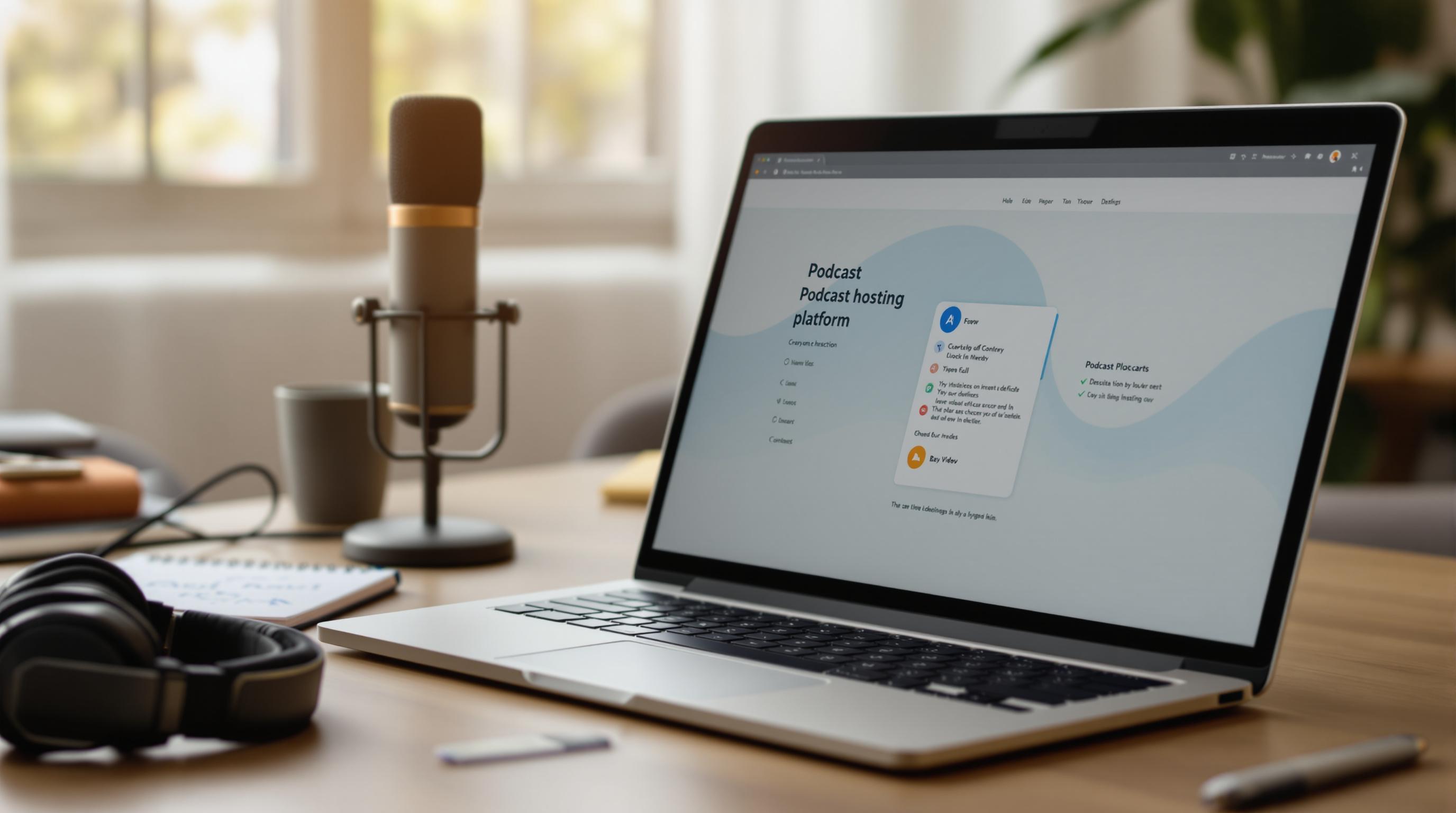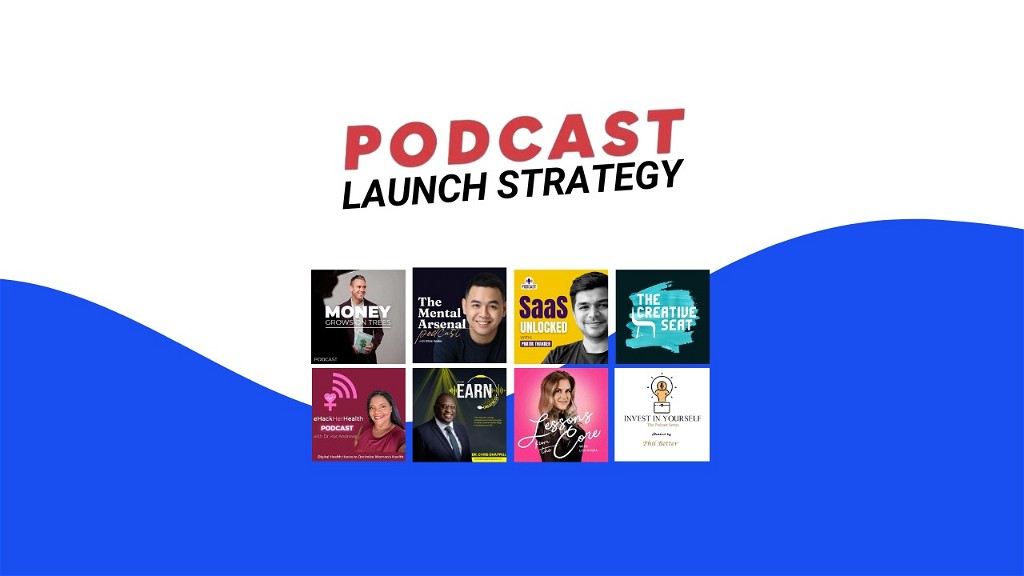Ready to start your podcast? Here's a quick guide to get you on the air:
- Define your podcast idea
- Choose your format
- Name and brand your show
- Get basic equipment
- Pick recording and editing software
- Plan your first episodes
- Record your podcast
- Edit your episodes
- Choose a hosting platform
- Launch and share your podcast
Quick Comparison of Popular Podcast Hosting Platforms:
| Platform | Price Range | Key Features |
|---|---|---|
| Buzzsprout | $0 - $24/mo | User-friendly, solid analytics |
| Podbean | $0 - $79/mo | Unlimited storage (paid plans) |
| Libsyn | $5 - $150/mo | Established since 2004 |
| Transistor | $19 - $199+/mo | Multiple show support |
| Spotify for Podcasters | Free | Basic features, beginner-friendly |
Remember:
- Start with a clear vision
- Stick to a consistent schedule
- Focus on quality content
- Be patient - growth takes time
With 46% of Americans listening to podcasts and global listeners expected to hit 160 million this year, there's never been a better time to start. Plan ahead, stay organized, and have fun creating your show!
Related video from YouTube
Define Your Podcast Idea
Picking the right podcast idea can make or break your show. Here's how to do it:
Pick Your Topic and Audience
Choose a topic you love. Why? You'll be talking about it A LOT. If you're a dietician, maybe focus on "high protein diets for busy people" like working moms or vegans.
Know your audience. Create a listener profile:
| Listener Profile | Details |
|---|---|
| Name | Sarah |
| Age | 35 |
| Job | Marketing manager |
| Location | Suburban U.S. city |
| Pain Points | No time for healthy meals, confused about nutrition |
| Interests | Cooking, fitness, health blogs |
Make Your Podcast Stand Out
There are MILLIONS of podcasts out there. How can you be different?
- Find a unique angle
- Use a specific format (interviews, storytelling)
- Target a niche audience
Don't just do a general parenting podcast. How about "working parents using humor to cope with challenges"?
Come Up with Episode Ideas
Brainstorm topics your audience will love. Try:
- Keyword research
- Common questions in your field
- Current trends
For a parenting podcast, you might do:
- "5 Quick Dinner Ideas for Busy Parents"
- "Laugh-Out-Loud Stories: When Kids Say the Darndest Things"
- "Balancing Work and Family: Tips from CEOs Who Are Parents"
2. Choose Your Podcast Format
Picking the right podcast format can make or break your show. Let's dive in:
Format Options
Here's a quick rundown of popular formats:
| Format | What It Is | Who It's For |
|---|---|---|
| Solo | Just you and the mic | Confident speakers with expertise |
| Interview | You + a guest | Networkers who love asking questions |
| Co-hosted | You + a partner | Duos with great chemistry |
| Panel | You + multiple guests | Deep dive enthusiasts |
| Storytelling | Narrative-style | Natural storytellers |
Pick what feels right for you and your topic.
Length and Schedule
How long should your podcast be? It depends:
- Short (15-20 mins): Perfect for daily tips
- Medium (20-45 mins): Great for most topics
- Long (45+ mins): Ideal for deep dives
For example, "The Daily" (20-25 mins) has 5 million listeners. "The Joe Rogan Experience" (1-3+ hours) averages 11 million per episode.
Consistency is key. Stick to your chosen schedule, whether it's daily, weekly, or bi-weekly.
Episode Structure
Every episode needs a solid structure:
- Intro (Hook 'em)
- Main content (Deliver the goods)
- Outro (Wrap it up)
For a chat-style show, try this:
- Intro
- Introductions
- Topic breakdown
- Discussion
- Q&A (if live)
- Wrap-up
- Call-to-action
- Outro
3. Name and Brand Your Podcast
Your podcast's name and brand are crucial. Here's how to nail it:
Pick a Good Name
Your podcast name should be short, easy to spell, and relevant to your content. For example, "How I Built This" perfectly captures the show's focus on founder stories.
Quick Tip: Include a keyword for searchability, but don't overdo it. "The Daily Entrepreneurship Business Startup Podcast" is too much.
Create Your Look
Your podcast needs a visual identity:
1. Logo: Keep it simple and readable, especially on small screens.
2. Cover Art: Make it eye-catching. Use bold colors, readable text, and avoid clichés like microphone images.
3. Color Scheme: Choose 2-3 colors that match your podcast's vibe. Use them consistently.
Write a Clear Description
Your description is your elevator pitch. Keep it short and answer:
- What's your podcast about?
- Who's it for?
- Why should they listen?
Redhanded's description nails it: "Spooky true crime stories told with humor and sass by two best friends."
"By taking the time to carefully consider your audience, develop your brand identity, create on-brand content, promote your podcast, and collaborate with other industry experts, you can set your podcast up for success and grow a loyal and engaged audience." - Casted Team
Don't let perfectionism stop you. You can always tweak your branding later. The key? Just get started!
4. Get Basic Equipment
You don't need fancy gear to start podcasting. Here's what you do need:
Choose a Microphone
Your mic is key. For beginners, go with a USB microphone:
- Plug and play
- Good sound for the price
Some solid options:
| Microphone | Price | Why It's Good |
|---|---|---|
| Blue Yeti | $84.99 | Versatile, popular |
| Samson Q2U | $59.99 | USB/XLR, cuts background noise |
| RØDE Podmic | $99 | Built-in pop filter, tough |
Want better sound? An XLR mic with an audio interface is your next step. It costs more and takes more setup, though.
Other Must-Haves
You'll also need:
- Headphones (around $50 for decent ones)
- Pop filter (often included with mics)
- Mic arm (keeps your desk clear)
Your Recording Space
No pro studio? No problem. Just:
- Find a quiet room
- Add blankets or pillows to cut echo
- Close windows, turn off noisy stuff
Rob Bell started The RobCast with just a Blue Yeti and a laptop in a basic space. He focused on content first and still succeeded.
5. Pick Recording and Editing Software
Choosing the right podcast software can make or break your show. Let's break it down:
Recording Software
Here's a quick look at some popular options:
| Software | Best For | Price |
|---|---|---|
| Audacity | Beginners | Free |
| GarageBand | Mac users | Free |
| Adobe Audition | Pro users | $22.99/month |
| Descript | Text-based editing | Free plan available |
Audacity? It's free and works on both Windows and Mac. Great for newbies.
GarageBand comes with your Mac. It's easy to use and good for podcasts and music.
Want pro features? Adobe Audition's your go-to. It's part of Creative Cloud.
Descript is the new kid on the block. Edit audio by editing text. Pretty cool, right?
Editing Tools
You can use the same software to edit. But some podcasters like separate tools:
- Hindenburg: Made for podcasters. Costs $12-30 monthly.
- Reaper: Powerful. $60 for a personal license.
- Auphonic: Auto-cleans your audio. Free for up to 2 hours/month.
Here's a tip: Try before you buy. Most paid options have free trials.
sbb-itb-cdb7710
6. Plan Your First Episodes
Planning episodes is crucial for a smooth, engaging podcast. Here's how:
Outline Your Episodes
Create a clear structure for each episode:
- Intro (30-60 seconds)
- Main content (bulk of the episode)
- Conclusion (60-90 seconds)
Write Intros and Outros
Your intro and outro are your episode's bookends. They set the tone and leave an impression.
For your intro:
- Keep it short (30-60 seconds)
- Include podcast name and brief explanation
- Introduce yourself and co-hosts
Sample intro:
"Welcome to BirdWorld, the podcast for bird lovers. I'm Hannah, your host and avid birdwatcher. Today, we're diving into the world of hummingbirds."
For your outro:
- Thank listeners
- Include a call to action
- Tease the next episode
Prepare Questions and Topics
For interviews or discussions, prepare questions or talking points. This keeps the conversation flowing.
Tips:
- Research your guest
- Start broad, then get specific
- Have follow-up questions ready
Remember: An outline is a guide, not a script. It keeps you on track while allowing natural conversation.
"Recording a podcast episode with no outline is like going zip-lining with no zipline." - Sweet Fish Media
7. Record Your Podcast
It's showtime! Here's how to nail your podcast recording:
Equipment Setup
Set up in a quiet room with soft surfaces. Put your mic 6-12 inches from your mouth, angled up. Use a pop filter to cut plosives. Wear headphones to catch audio issues.
Speak Like a Pro
Warm up your voice first. Talk clearly at a steady pace. Stay hydrated and munch an apple to keep your mouth noise-free. Don't fidget - it creates unwanted sounds.
Fix Common Issues
| Problem | Fix |
|---|---|
| Background noise | Use a dynamic mic |
| Echo | Hang heavy fabrics around |
| Distortion | Lower recording levels |
| Vibrations | Use a shock mount |
Pro tip: Record each person on their own channel. It'll make editing WAY easier.
"Your closet is one of the best places to podcast. It's small (which means less surface area to create echos) and full of soft materials that absorb sound." - Castos Team
Closet podcasting? It's a thing. Small space, soft stuff - perfect for clear audio.
8. Edit Your Episodes
Time to polish your podcast. Good editing can transform your recording into a top-notch show.
Clean Up Your Audio
First, tackle background noise. Use tools like iZotope RX or Audacity to:
- Cut out hums and buzzes
- Remove sudden noises (coughs, phone rings)
- Fix audio clipping
Here's a quick guide to common audio issues:
| Problem | Solution |
|---|---|
| Hiss or hum | Noise reduction tools |
| Pops and clicks | De-click processor |
| Distortion | De-clip function |
| Sibilance | De-esser |
Pro tip: Edit each speaker's audio on a separate track.
Add Music and Sound Effects
Music and effects can spice up your podcast. But don't go overboard:
- Pick tracks that match your show's vibe
- Use short clips for intros and outros (5-10 seconds)
- Balance volume so music doesn't drown out speech
- Smooth fade-ins and fade-outs
Where to find music:
- Epidemic Sound: $9/month (annual plan)
- PremiumBeat: $65/month for 5 downloads
- FreePD.com: Free tracks, no attribution needed
"The only real rule is that it should sound good and engage your listener." - Hannah Hethmon, Better Lemon Creative Audio
Start simple with intro and outro music. You can always add more later.
9. Choose a Hosting Platform
Picking a hosting platform is crucial for sharing your podcast. Here's what you need to know:
Compare Hosting Services
When choosing a host, consider:
- Storage and bandwidth limits
- Analytics tools
- Ease of use
- Distribution features
- Price
Here's a quick comparison of popular hosting platforms:
| Platform | Price Range | Key Features |
|---|---|---|
| Buzzsprout | $0 - $24/month | User-friendly, solid analytics |
| Podbean | $0 - $79/month | Unlimited storage (paid plans) |
| Libsyn | $5 - $150/month | Established since 2004 |
| Transistor | $19 - $199+/month | Multiple show support |
| Spotify for Podcasters | Free | Basic features, beginner-friendly |
RSS Feeds: The Podcast Backbone
RSS feeds are crucial for podcast distribution. They contain your show's info and help listeners find you. Most hosts create this automatically.
"No RSS feed? Your potential listeners might struggle to find your podcast."
Upload Your Episodes
After choosing a host:
- Set up your show's profile
- Upload audio files
- Add episode details
- Set publish date
Upload tips:
- Use high-quality MP3 files (128 kbps standard)
- Write clear, keyword-rich descriptions
- Add episode artwork if possible
10. Launch and Share Your Podcast
Time to get your podcast out there. Here's how:
List Your Podcast in Directories
Submit to major directories:
-
Apple Podcasts: 28 million listeners. Create an Apple ID, use Apple Podcasts Connect, add your RSS feed.
-
Spotify: 28.2 million monthly listeners expected. Use Spotify for Podcasters, add RSS feed URL, verify by email.
-
Google Podcasts: 50 million downloads. Often auto-appears if on Apple Podcasts.
-
Others: Try Stitcher, TuneIn, Amazon Music, iHeartRadio, Podchaser.
"Early ratings and reviews speed up listener growth." - Castos
Plan Your Launch
Make an impact:
- Drop 3-5 episodes on day one. Gives listeners a taste, avoids "where's the content?" complaints.
- Tease pre-launch to build buzz.
- Run a contest. Gets shares and reviews.
Use Social Media to Promote
Spread the word:
- Pick platforms your audience uses.
- Share teasers and soundbites.
- Try Ausha for auto-sharing.
- Team up with other podcasters.
| Platform | Good For |
|---|---|
| Visuals, behind-scenes | |
| Quick updates, listener chats | |
| Pro topics, networking | |
| Community, longer posts |
First two weeks? Crucial. Aim for downloads and good reviews. Apple Podcasts can drive 70% of listens, so focus there.
Conclusion
Starting a podcast isn't easy. But if you follow these 10 steps, you'll be on track to share your voice with the world.
Here's what really matters:
| Key Factor | Why It Matters |
|---|---|
| Clear Vision | Guides your content and audience |
| Consistent Schedule | Builds trust and keeps listeners |
| Quality Content | Makes people come back |
| Patience | Growth takes time |
Don't worry if your numbers are low at first. University FM says:
"Not everyone blows up overnight—in fact, consistency over time is often one of the best ways to achieve success as a content creator."
Some quick tips:
- Record a few episodes before you launch
- Talk to your listeners
- Improve based on feedback
You're joining a big club. 46% of Americans listen to podcasts, and global listeners could hit 160 million this year.
Caitlin Sellers Castevens warns:
"A lot of people don't do enough planning and then choke halfway through the season because they can't keep up with production."
So plan ahead, stay organized, and have fun creating your podcast.
FAQs
What is the best platform to host your podcast?
Picking the right hosting platform can make or break your podcast. Let's look at some top contenders:
| Platform | Standout Feature |
|---|---|
| Blubrry | WordPress integration |
| Libsyn | Wide distribution |
| Captivate | Unlimited podcasts |
| Simplecast | Team collaboration |
| Megaphone | Dynamic ad insertion |
| Spotify for Podcasters | Free option |
| Spreaker | Live broadcasting |
| Castos | Private podcasting |
When choosing, think about:
- Cost
- Storage and bandwidth
- Analytics
- Distribution reach
- Money-making options




